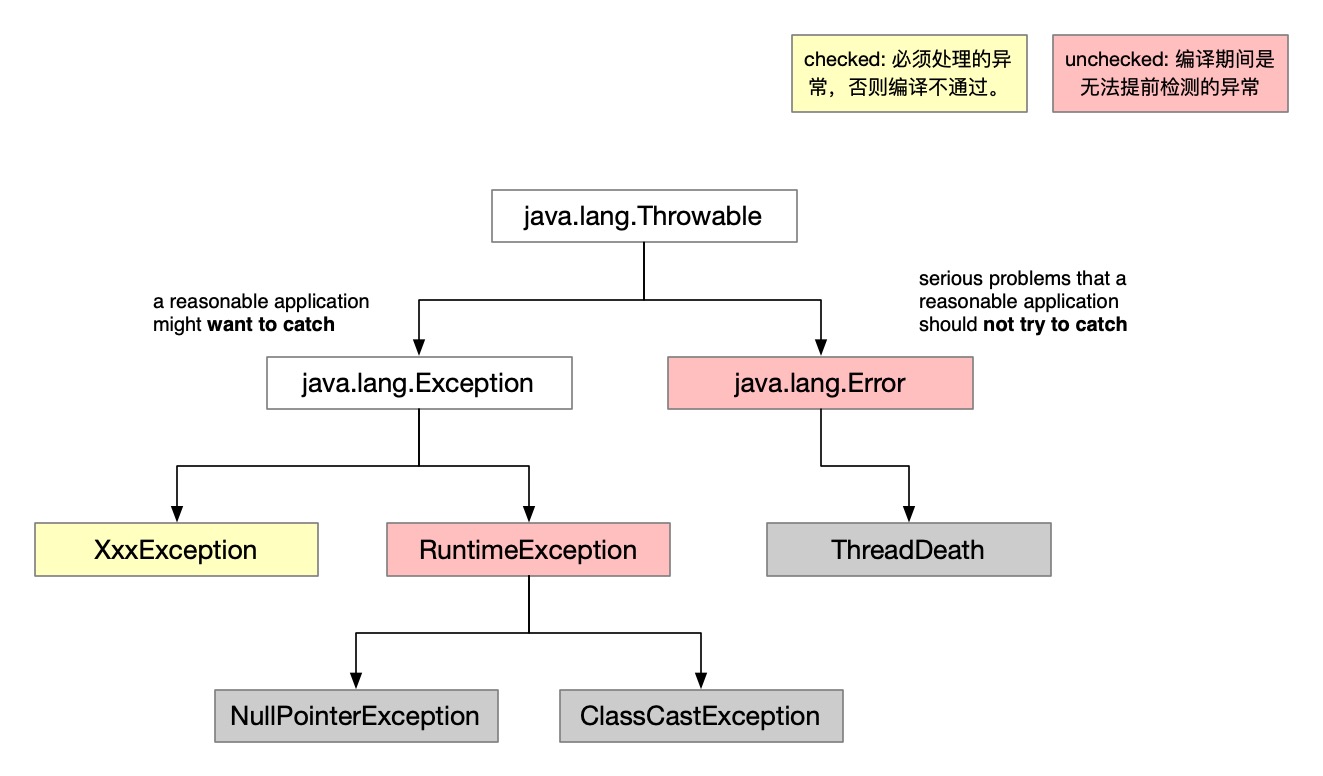天使还是恶魔!浅谈 Java 中的 checked exception
记得有一次,觉得处理异常太麻烦,直接 catch 后包装一个 RuntimeException 一路抛了上去。结果被小伙伴 CR 时喷了一顿~
这篇文章将简单介绍 Java 中异常的分类,使用 checked exceptions 的最佳时机,以及为什么无脑抛 RuntimeException 不是一个好习惯。最后分享如何在 lambda 表达式中,更加优雅的处理 checked exceptions。
异常分类
Java 中所有异常都继承自Throwable,一般简单将异常分为:
- checked exception: 调用方必须显性处理的异常,否则编译不通过。
- unchecked exception: 编译期间是无法提前检测的异常,又细分为
RuntimeException,例如臭名昭著的 NPEError: JVM 抛出异常,例如OutOfMemoryError等

使用 Checked Exceptions 的最佳时机
参考《Effective Java》中 Item 70:
Use checked exceptions for recoverable conditions and runtime exceptions for programming errors. By throwing a checked exception, you force the caller to handle the exception in a catch clause or to propagate it outward. Each checked exception that a method is declared to throw is therefore a potent indication to the API user that the associated condition is a possible outcome of invoking the method.
使用 checked exception 简单的指导原则:异常是否可恢复,简而言之即调用方是否有能力处理异常,并做出积极的响应,最终从异常中恢复。例如尝试打开一个不存在的文件,异常被调用方捕捉后,提示用户重新输入文件路径,也是一种所谓的 recoverable conditions。
否则如果因为编程错误等,无法恢复的情况,则使用 runtime exceptions 尽早让程序结束掉更为合适。
所以为什么不能无脑抛 RuntimeException?
哈哈,偶遇这个提问,如果不是翻译自 StackExchange 真的怀疑是不是我同事的困惑。

举个栗子:假如有一段线上告警后置处理的逻辑,其中一段子步骤为日志的抽样检查,但是因为网络等原因,存在小概率日志拉取失败的异常。这时套用「指导原则」需要抛出一个 checked exception,最终由调用方决定执行重试,或直接跳过该“弱依赖”,对异常进行恢复。
这时如果直接包装为 RuntimeException 无脑抛上去,则可能会中断整个告警后置处理的逻辑,甚至导致故障告警发不出来,显然是不合适的。
篇外:如何在 stream 中更优雅的处理异常
上文说到,针对 checked exceptions,调用方必须显性的捕捉并处理,但这也是为什么很多程序员对它深恶痛绝。
更加可恨的是,在 Java8 的 stream 中,不支持直接抛出 checked exceptions.. 所以很容易写出丑陋的代码:
import java.util.Arrays;
class Scratch {
public static void main(String[] args) {
String[] clazzList = new String[]{"java.util.TreeSet", "2"};
Arrays.stream(clazzList)
.map(s -> {
try {
return Class.forName(s);
} catch (ClassNotFoundException e) {
throw new RuntimeException(e);
}
})
.forEach(System.out::println);
}
}
一种解决办法是使用 vavr 包:
import io.vavr.CheckedFunction1;
import io.vavr.control.Try;
import java.util.Arrays;
import java.util.List;
import java.util.stream.Collectors;
class Scratch {
public static void main(String[] args) {
String[] clazzList = new String[]{"java.util.TreeSet", "2"};
List<Try<? extends Class<?>>> collect = Arrays.stream(clazzList)
.map(CheckedFunction1.liftTry(Class::forName))
.collect(Collectors.toList());
// 打印异常
collect.forEach(x -> x.onFailure(System.out::println));
// 打印正常结果
collect.forEach(x -> x.onSuccess(System.out::println));
}
}
THE END
查看资料的过程中,发现大家对 Java 中的 checked exceptions 是天使还是恶魔的争论十分激烈。
但个人觉得 checked exceptions 还是利大于弊的,合理使用会有效提升接口和程序整体的健壮性。
参考:
- https://web.archive.org/web/20171216175508/www.yinwang.org/blog-cn/2017/05/23/kotlin
- 《Effective Java》Item 70 & Item 71
- https://softwareengineering.stackexchange.com/questions/121328/is-it-good-practice-to-catch-a-checked-exception-and-throw-a-runtimeexception/121385#121385
- https://github.com/kun-song/my-blog/issues/36